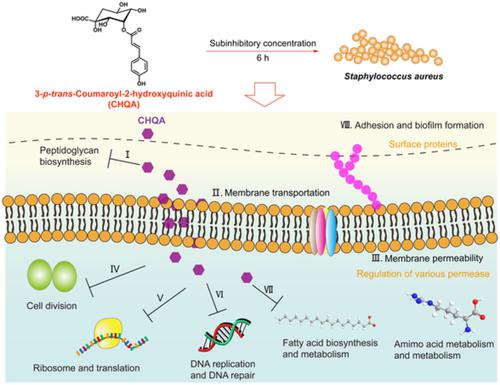当前位置:
X-MOL 学术
›
J. Food Saf.
›
论文详情
Our official English website, www.x-mol.net, welcomes your
feedback! (Note: you will need to create a separate account there.)
Discovering the antibacterial mode of action of 3‐p‐trans‐coumaroyl‐2‐hydroxyquinic acid, a natural phenolic compound, against Staphylococcus aureus through an integrated transcriptomic and proteomic approach
Journal of Food Safety ( IF 1.9 ) Pub Date : 2020-09-23 , DOI: 10.1111/jfs.12861 Xiaoyan Liu 1 , Yuxi Yue 1 , Yanping Wu 1, 2 , Kai Zhong 1, 2 , Qian Bu 1, 2 , Hong Gao 1, 2
Journal of Food Safety ( IF 1.9 ) Pub Date : 2020-09-23 , DOI: 10.1111/jfs.12861 Xiaoyan Liu 1 , Yuxi Yue 1 , Yanping Wu 1, 2 , Kai Zhong 1, 2 , Qian Bu 1, 2 , Hong Gao 1, 2
Affiliation

|
A plant‐derived phenolic compound, namely 3‐p‐trans‐coumaroyl‐2‐hydroxyquinic acid (CHQA), has recently been reported to exhibit antibacterial and antibiofilm activities against Staphylococcus aureus. In this study, the combined transcriptomic and proteomic analyses was used to elucidate the molecular mechanism of CHQA against S. aureus. The results showed that subinhibitory concentration of CHQA induced wide and significant changes in S. aureus at both transcriptional and translational levels with 935 differentially expressed genes and 438 differentially expressed proteins. Bioinformatic analysis indicated that the changed genes and proteins were mainly involved in cell membrane, ribosome and translation, DNA repair, fatty acid biosynthesis and metabolism, amino acid biosynthesis, peptidoglycan synthesis, and bacterial infection. Moreover, downregulation of various surface proteins associated with cell adhesion was observed, which probably further inhibited the biofilm formation of S. aureus. These results revealed that CHQA exerted antibacterial activity through multifarious mechanisms, which especially targeted bacterial cell membrane and then triggered diverse cellular dysfunctions.
中文翻译:

通过整合的转录组和蛋白质组学方法,发现天然酚类化合物3-对-反-香豆酰基-2-羟基奎尼酸的抗菌作用模式
最近有报道说,一种植物来源的酚类化合物,即3-对-反-香豆酰基-2-羟基奎尼酸(CHQA)对金黄色葡萄球菌具有抗菌和抗生物膜活性。在这项研究中,结合转录组和蛋白质组学分析来阐明CHQA对抗S的分子机制。金黄色的。结果表明,CHQA的亚抑制浓度引起了S的广泛而显着的变化。金黄色在转录和翻译水平上都有935个差异表达的基因和438个差异表达的蛋白。生物信息学分析表明,改变的基因和蛋白质主要涉及细胞膜,核糖体和翻译,DNA修复,脂肪酸生物合成和代谢,氨基酸生物合成,肽聚糖合成和细菌感染。此外,观察到与细胞粘附相关的各种表面蛋白的下调,这可能进一步抑制了S的生物膜形成。金黄色的。这些结果表明,CHQA通过多种机制发挥抗菌活性,尤其是针对细菌细胞膜,然后引发多种细胞功能障碍。
更新日期:2020-09-23
中文翻译:

通过整合的转录组和蛋白质组学方法,发现天然酚类化合物3-对-反-香豆酰基-2-羟基奎尼酸的抗菌作用模式
最近有报道说,一种植物来源的酚类化合物,即3-对-反-香豆酰基-2-羟基奎尼酸(CHQA)对金黄色葡萄球菌具有抗菌和抗生物膜活性。在这项研究中,结合转录组和蛋白质组学分析来阐明CHQA对抗S的分子机制。金黄色的。结果表明,CHQA的亚抑制浓度引起了S的广泛而显着的变化。金黄色在转录和翻译水平上都有935个差异表达的基因和438个差异表达的蛋白。生物信息学分析表明,改变的基因和蛋白质主要涉及细胞膜,核糖体和翻译,DNA修复,脂肪酸生物合成和代谢,氨基酸生物合成,肽聚糖合成和细菌感染。此外,观察到与细胞粘附相关的各种表面蛋白的下调,这可能进一步抑制了S的生物膜形成。金黄色的。这些结果表明,CHQA通过多种机制发挥抗菌活性,尤其是针对细菌细胞膜,然后引发多种细胞功能障碍。











































 京公网安备 11010802027423号
京公网安备 11010802027423号